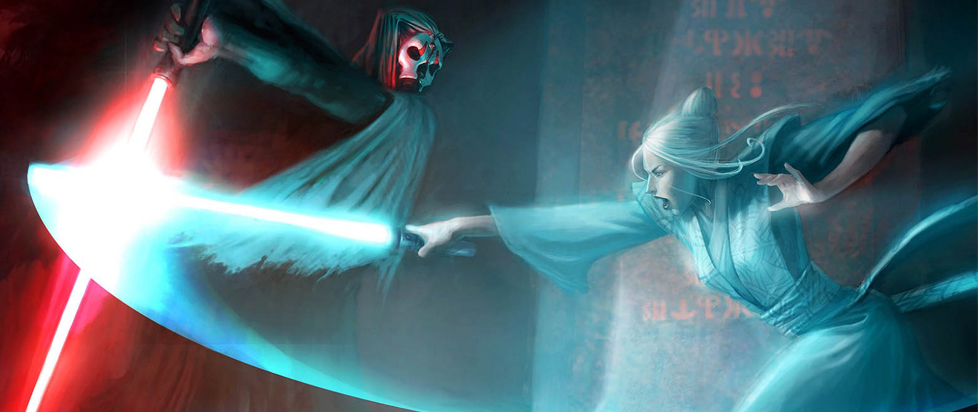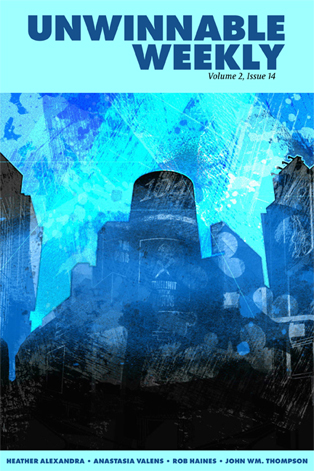
A Ship of Broken Jedi
As its impressively verbose title indicates, Star Wars: Knights of the Old Republic 2: The Sith Lords is a Star Wars game, considered by many to be something of an ugly duckling in the Star Wars Expanded Universe (rest in peace) which, if we’re being honest, was never flush with swans. And yet, I love KOTOR2 like few others.
The first KOTOR is near-universally beloved, a good game that cleansed the palate of Star Wars fans still sour over the sleepy, leaden prequel trilogy of films. The story of a Jedi civil war threatening a Galactic Republic thousands of years before the events of either film trilogy (a particularly fertile time in the now-defunct Star Wars Expanded Universe) ably captured the space opera resonance of the classic trilogy, right down to the third-act twist. It was bright in color and tone, it moved at a clip, you could start a doomed romance or order a wookie to kill a teen. It was revelatory, for its time.
Beyond being a watershed for western RPGs during the rise of modern gaming consoles, the original KOTOR served as a crucible for its developer, BioWare, establishing what the studio is today and solidifying its house style (with the exception of the concurrently-developed Neverwinter Nights, every subsequent BioWare game has mirrored KOTOR in vital ways). The studio was eager to move on to original stories and settings, however, so the series passed into the hands of Obsidian Entertainment, a fledgling company largely made up of developers from the defunct Black Isle Studios, who had worked closely with BioWare as publishers during their fledgling days of making PC Dungeons & Dragons games.
KOTOR2’s development was troubled. It was made, at the behest of LucasArts, in 13 months, which was not enough time at all when it comes to large-scale games. Players who bought it discovered a game at turns deeply vivid and extremely incoherent. Unfinished scenes were cut from the game’s  ending at such a scale that its temporal and spatial confusion became legend and the Obsidian name became synonymous with shoddy incompleteness (such furor, right or wrong, would not be seen again until people got to the end of Mass Effect 3). In part, this was due to the publisher releasing it early to catch holiday sales, but it was also Obsidian’s first game as an independent entity and they made numerous mistakes.
ending at such a scale that its temporal and spatial confusion became legend and the Obsidian name became synonymous with shoddy incompleteness (such furor, right or wrong, would not be seen again until people got to the end of Mass Effect 3). In part, this was due to the publisher releasing it early to catch holiday sales, but it was also Obsidian’s first game as an independent entity and they made numerous mistakes.
Despite all this, the game retains a hardy following. In game development, as in nearly any collaborative medium, there is a persistent tendency for people to attribute the success of a project to a singular “visionary” personality, and in KOTOR2’s case, much of what made it special was attributed to the project lead, Chris Avellone. It’s not difficult to see why.
Avellone had cut his teeth at Black Isle Studios, a development house famed for a string of beloved RPGs of the late 90’s, including the first two Fallout games and Planescape: Torment, which single-handedly made Avellone’s name as a writer and designer. Torment was a breathtakingly weird game, even for one set in the terminally weird Planescape offshoot of D&D. It offered, and continues to offer, a singular experience.
Torment eschewed emphasis on combat in favor of a stunning amount of prose text and dialogue, parceled out into sprawling conversations in the game’s cosmic setting. These conversations usually concerned themselves with broad philosophical problems regarding identity, choice and responsibility. You mused and argued over these things with demons, physical embodiments of universal concepts, ghosts of past-life lovers and your own soul. The game’s protagonist, a man cursed to never die, stuck in a cycle of making choices and forgetting about them, is searching for answers, not a fight. The journey is partly about defining oneself while also facing the inherited consequences of choices that aren’t yours. At the end, you can “win” the game simply by having a well-considered answer to a single question. It’s a strange experience, and one that is considered by many, even among the mainstream, to be the best-written game ever made. It is in many ways a critical reaction to the staid, straightforward high fantasy of more popular strains of D&D.
You’ve been reading an excerpt from Unwinnable Monthly Issue 66.
To read the article in its entirety, please purchase the issue from the shop or sign up for a subscription to Unwinnable Monthly!





